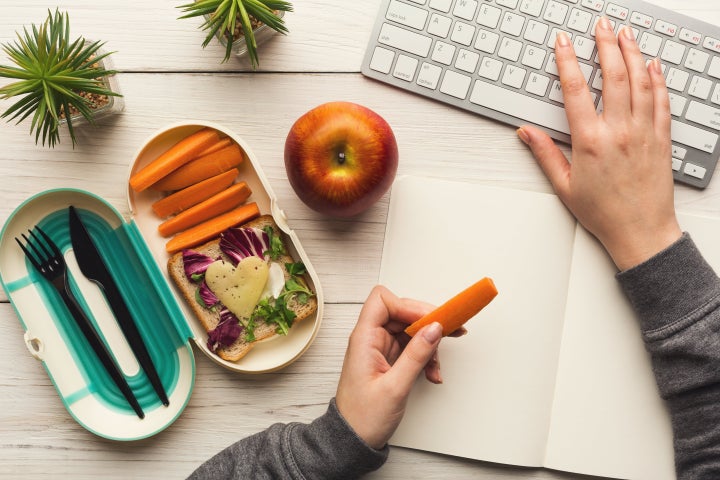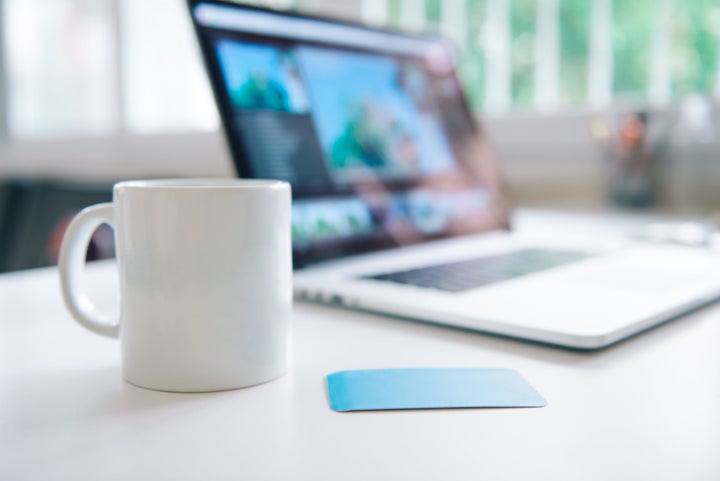Working from home during the coronavirus pandemic means distractions like water coolers and small talk are in the rearview mirror, but in the era of social distancing, one major work-from-home distraction remains: the refrigerator.
Have a deadline? Sure, but first, you should probably check on last night’s leftovers — just for a quick little bite. Starting a project? You’ll need brain food, obviously. Of course, you’ve already had breakfast (and lunch — and snacks).
Food can be a remote worker’s worst enemy, and sometimes the efficiency of working from home leads to people straight-up forgetting to eat at all.
Since overeating and undereating aren’t sustainable habits, we talked with veteran remote workers about their tried-and-true strategies for eating healthily while working from home.
Stick To A Schedule
Successful freelancers swear by routines — washing your face, putting on real clothes and setting smartphone boundaries — and those recommendations extend to eating. Nutritional therapist and longtime work-from-homer Wilma MacDonald told HuffPost that snacking here and there is the biggest mistake she sees new remote workers make. She recommends setting up your day like any regular working day, with a lunch break, a few smaller breaks and a focus on the most important meal: breakfast.
“Eat breakfast away from your desk before you start work,” MacDonald said. “Think of something like warm oats with nut butter and fruit, or avocado and eggs on toast. Protein-rich breakfasts keep you full and keep your sugar levels balanced so you’re not looking for a snack in an hour.”

Lucille Whiting, founder of jewelry brand Sophia Alexander, has juggled working from home with five kids for the past 14 years. She recognizes schedules are a bit crazy, but finds following the needs of her children works best. “I try to eat when the children are eating, so breakfast with my toddler, lunch together before his afternoon nap and dinner all together in the evening,” she told HuffPost. “I buy or make cakes and biscuits for the children after mealtimes, but often make just enough for them to help me avoid temptation.”
When You Can, Eat Away From Your Desk
It’s easy to think eating breakfast or lunch at your desk could help you end the day early, but work-from-home veterans know it rarely works this way. There’s always something more to do, and your focus dwindles without dedicated breaks. That’s why MacDonald suggests eating all meals away from not just your desk, but your tech.
Whiting agrees — she institutes a no-tech at dinnertime rule — but she will work through lunch when her kids are occupied. For her, parenting while working from home is all about being flexible. “Having a total break from work helps clear my mind, but if I’m on my own when the children are sleeping or out, I almost always eat lunch at my desk,” she said. “There’s always the temptation to keep working and get as much done as possible. Having the children around gives my day a healthy structure.”
Set Caffeine Boundaries And Increase Hydration
Those new to the work-from-home lifestyle are often astounded by how much coffee they drink. If you brew a pot, you don’t want to waste any, and you end up drinking way more than you ever would at work. Surprisingly, this isn’t the worst thing you could do for your health. The FDA says 400 milligrams (the equivalent of four to five cups of coffee) is typically safe, depending on the person. The important thing is timing.
“If you drink caffeine, have your coffee between 9 and 11 a.m.,” MacDonald said. “This is the best time to have caffeine so that it doesn’t interrupt your natural sleep and wake cycle by triggering a release of adrenaline and setting you up for a crash in an hour.”

Coffee gets people out of bed in the morning, but the same can’t be said for water. A 2016 report by the CDC showed most American adults between 20 to 60 years old drink barely enough water, while adults over age 60 drink less than recommended. In addition to hydration benefits, MacDonald says water can help people feel full, because thirst is often mistaken for hunger.
Whiting’s go-to hydration trick is to make water easily accessible. “I keep a pint glass of water on the worktop at all times,” she said. “The glass sitting there acts as a reminder, and it helps me avoid unnecessary snacking when I’m not really hungry.”
Keep Healthy Snacks Ready
You don’t want to overdo it with snacking, but you also don’t want to starve yourself. That’s why MacDonald recommends taking personal inventory prior to hitting the refrigerator. “Before you head to the snacks, check in with yourself,” she said. “Are you eating because you’re hungry or because you’re bored, stressed, annoyed or lonely? We eat our emotions from time to time. Feel those feelings — especially now — then have a drink of water.”
When it is hunger, not procrastination or emotions, MacDonald leans on go-to snacks like chopped carrots, pepper, celery with hummus, or stuffed dates with nut butter. “Smoothies are also good to have because they’re hydrating and you’re getting a boost of goodness,” she said. “Start with a base of a green vegetable, add fruit, some protein like chia seeds or protein powder, and some fat like nut butter.”
Whiting says fruit is her favorite snack, and it’s something her children can enjoy, too. “I have loads of apples and pears around, which is easy with small children,” she said. “I buy a lot so they have healthy things to snack on, and I buy extra for whenever I get hungry between meals.”
But sometimes, snacking isn’t the answer. Judy Bartkowiak, author and neuro-linguistic programming (NLP) trainer and 30-year work-from-home veteran, sticks to a disciplined, no-snack approach. “I eat a big healthy breakfast, and stick to eating three times a day,” she told HuffPost. “That way, I don’t even think of going to the fridge during the work day except to get something at lunchtime.”
Keep A Food Journal
Nutrition is highly personal, and what works for one person may not work for another. That’s why MacDonald recommends journaling during your first few weeks working at home. “Keep track of how you’re feeling over the course of the day energy-wise, and keep a food diary to see any patterns emerging,” she said.
At the same time, self-isolation due to a pandemic is different than casually working from home. It’s all about adapting to these emotional weeks and months, and taking life in stride.
“You might find yourself eating everything at first, then you realize how sluggish it makes you feel,” she said. “It takes a while to find your groove, and these are weird times. As people adapt to working from home, they need to give themselves grace.”
